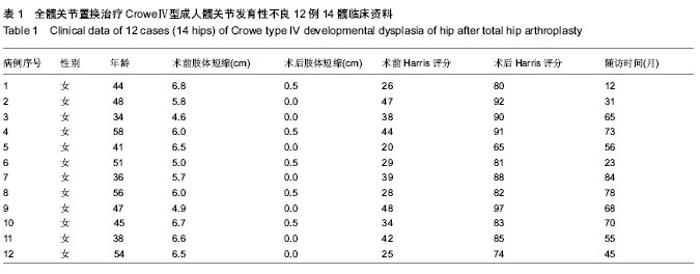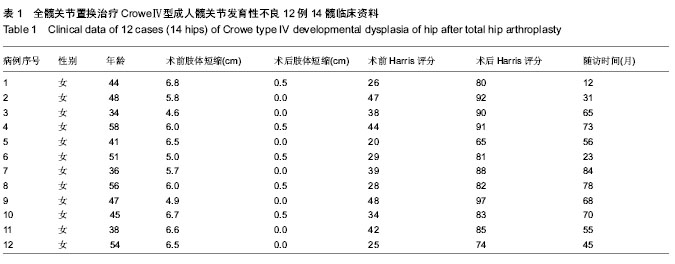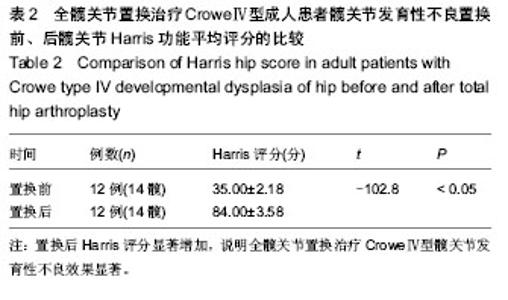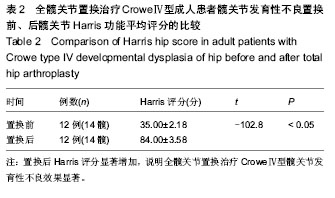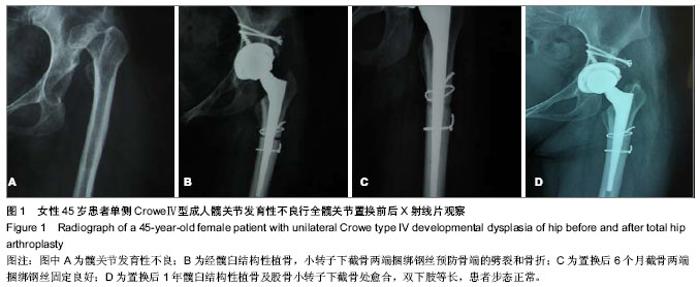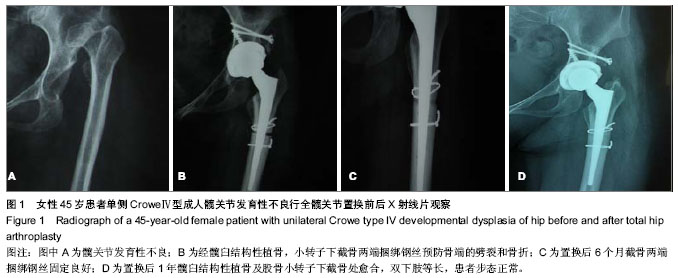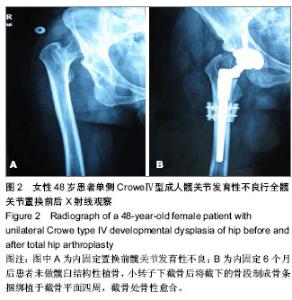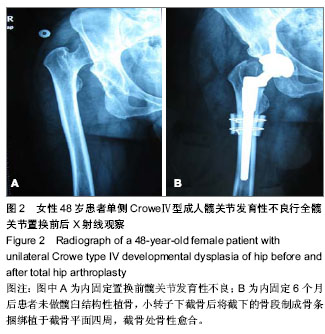| [1] Shi D,Dai J,Zhu P,et al.Association of the D repeat polymorphism in the ASPN gene with developmental dysplasia of the hip :a case-control syudy in Han Chinese. Arthritis Res Ther. 2011;13(1):R27. [2] Chougle A,Hemmady MV,Hodgkinson JP.Severity of hip dysplasia and loosening of the socket on cemented total hip replacement.J Bone Joint Surg Br. 2005;87(1):16-20. [3] 吕厚山.现代人工关节外科学[M].北京:科技出版社,2006: 576-584.[4] 李梁涛,谷贵山.人工关节置换治疗成人髋关节发育不良的新进展[J].实用骨科杂志,2012,18(6):523-526. [5] Harley JM, Wilkinson JA. Hip replacement for adults with unreduced congenital dislocation. A new surgical technique. J Bone Joint Surg Br. 1987;69(5):752-755. [6] 严建锋,符培亮,李强,等.人工髋关节置换后的双下肢不等长[J]. 中国组织工程研究,2012,16(52):9844-9851.[7] 杨述华,许伟华,叶树楠,等.髋臼重建及股骨转子下短缩截骨全髋关节置换治疗CroweIV型髋关节发育不良[J].中华骨科杂志, 2013, 33(9):888-894.[8] Kilicoglu OI, Turker M, Akgul T, et al. Cementless total hip arthroplasty with modified oblique femoral shortening osteotomy in Crowe type 1V congenital hip dislocation. J Arthroplasty. 2013;28(1):117-125.[9] Takao M, Ohzono K, Nishii T, et al. mentless modular total hip arthroplasty with subtrochanteric shortening osteotomy for hips with developmental dysplasia. J Bone Joint Surg Am. 2011;93(6):548-555.[10] Yalcin N, Kilicarslan K, Karatas F, et al. Cementless total hip arthroplasty with subtrochanteric transverse shortening osteotomy for severely dysplastic or dislocated hips. Hip Int. 2010;20(1):87-93. [11] 刘兴炎,高秋明,樊晓海,等.高龄患者髋臼发育不良全髋置换术的围手术期准备与疗效分析[J].中国矫形外科杂志,2010,11(9): 705-708.[12] Crowe JF, Mani VJ, Ranawat CS. Total hip replacement in congenital dislocation and dysplasia of the hip. J Bone Joint Surg Am.1979;1A:15-23.[13] 徐灵军,朱海波,张银网,等. 人工髋关节活体有限元建模及力学分析[J]. 中国组织工程研究,2012,16(26):4770-4775.[14] Decking J,Decking R,Schoellner C,et al.Cementless total hip replacement with subtrochanteric femoral shortening for severe developmental dysplasia of the hip.Arch Orthop Trauma Surg.2003;123(7):357-362.[15] Bolder SBT,Melenhorst J,Gardeniers JW,et al.Cemented total hip arthroplasty with impacted morcellized bone grafts to restore acetabular bone defects in congenital hip dysplasia. J Arthroplasty. 2001;16(8 Suppl 1):164-169.[16] Tsukada S, Wakui M. Bulk femoral head autograft without decortica- tion in uncemented total hip arthroplasty: seven- to ten-year results. J Arthroplasty. 2012;27(3):437-444.[17] Faldini C, Nanni M, Leonetti D, et al. Total hip arthroplasty in devel- opmental hi p dysplasia using cementless tapered stem. Results aer aminimum 10-year follow-up. Hip Int. 2011; 21(4): 415-420.[18] Boyle MJ, Frampton CM, Crawford HA. Early results of total hip arthroplasty in patients with developmental dysplasia of the hip compared with patients with osteoarthritis. J Arthroplasty. 2012;27(3): 386-390.[19] Dorr LD,Tawakkol S,Moorthy M,et al.Medial protrusion technique for placement of a porous-coated,hemispherical acetabu1ar component without cement in a total hip arthroplasty in patients who have acetabular dysplasis.J Bone Joint Surg Am. 1999;81(1):83-92.[20] Saito S, Ishii T, Mori S, et al. Long-term results of bulk femoral head autograft in cementless THA for developmental hip dysplasia. Orthopedics. 2011;34(2):88. [21] Kim M, Kadowaki T. High long-term survival of bulk femoral head autograft for acetabular reconstruction in cementless THA for developmental hip dysplasia. Clin Orthop Relat Res. 2010;468(6):1611-1620.[22] 陈及非,阎作勤,陈云苏.利用股骨头结构性植骨人工全髋关节置换治疗Crowe Ⅱ型和Ⅲ型髋关节发育不良[J].中国修复重建外科杂志,2010,24(3):270-273.[23] 李文波,张文明,白国昌,等.人工全髋关节置换术治疗成人Crowe Ⅳ型先天性髋关节发育不良伴脱位[J].中国修复重建外科杂志, 2013,27(10):1153-1156.[24] 宋立明,张铁良,毕晓阳,等.严重髋关节发育不良的全髋关节置换术[J].中华骨科杂志,2010,19(2):159-163.[25] Masonis JL,Patel JV,Miu A.Subtrochanterie shortening and derotafional osteotomy in primary total hip arthmplasty for patients with severe hip dysplasia:5-year follow-up.J Arthroplasty. 2003;18:68-73.[26] 周勇刚,张强,王岩,等.两种不同截骨方法治疗Crowe IV型先天性髋脱位的比较研究[J].中华外科杂志,2008,46(17): 1288-1292.[27] Bruce WJ,Rizkallah SM,Kwon YM,et al.A new technique of subtrochanteric shortening in total hip arthroplasty:Surgical technique and results of 9 cases.J Arthroplasty.2000;15(5): 617-626. [28] 李彪,郭双红,龚跃昆,等. 股骨转子下叠加截骨的人工全髋关节置换术治疗CroweⅣ型成人发育性髋关节发育不良[J]. 中国修复重建外科杂志,2013,27(6):645-648.[29] Chougle A,Hemmady MV,Hodgkinson JP.Severity of hip dysplasia and loosening of the sochet on cemented total hip replacement.J Bone Joint Surg Br.2005;87(1):16-20.[30] Reikeras O,Haaland JE,Lereim P.Femoral shortening in total hip arthroplasty for high developmental dysplasia of the hip.Clin Orthop.2010;7:1949-1955.[31] 何少斌,刘平. 全髋关节置换术治疗老年髋关节发育不良继发骨关节炎患者的临床疗效研究[J]. 实用临床医药杂志,2013, 17(19): 138-139.[32] 鲁宁,杨阳,苗绍刚. 全髋关节置换术后血栓性疾病危险因素多元回归分析[J]. 上海医学,2013,36(9):772-774.[33] 郭蒙,姜保国,付中国. 髋关节置换术中骨水泥填充对血压的影响及干预[J]. 北京大学学报:医学版,2013,45(5):693-697.[34] Khanna G, Cemovsky J. Bone cement and the implications for anaesthesia[ J]. Continuing Education in Anaesthesia, Critical Care & Pain. 2012;12(4):213-216. [35] 张楠,刘金煜,周永焘.改良后外侧切口人工髋关节置换术(THA)术后Harris评分及临床疗效分析[J].中国伤残医学,2013,21(9): 97-98. |
